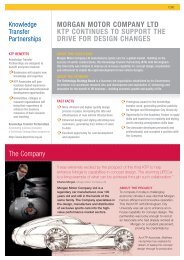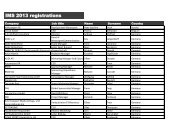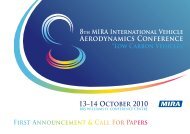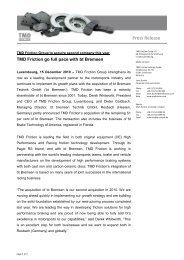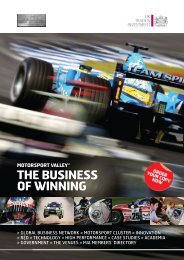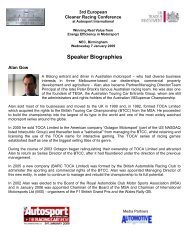High Speed Craft, Performance & Protection
High Speed Craft, Performance & Protection
High Speed Craft, Performance & Protection
- No tags were found...
Create successful ePaper yourself
Turn your PDF publications into a flip-book with our unique Google optimized e-Paper software.
HIGH SPEED CRAFT- PERFORMANCE & PROTECTION -Dr Trevor DobbinsSTResearch Ltd, UK - STResearch LLC, USA
TOPICS• The high speed marine environment• Shock & vibration• Shock mitigation• Crash safety• Design
STResearch<strong>High</strong> <strong>Speed</strong> <strong>Craft</strong> Human Factors– Research– Design– Test & EvaluationExamplesOther related work:– Yacht racing– Motor racing– Aviation– EU and US
“<strong>High</strong> <strong>Speed</strong> <strong>Craft</strong> provide one of theworst operating environments due toexposure to high levels of Shock&Vibration”Ensign, et al (2000), A survey of self-reported injuries among special boatoperators; Naval Health Research Centre, Tech Report 00-48Carvalhais, (2004) Incidence and severity of injury to surf boat operators.Conference Proceedings 75th SAVIAC Conference, Virginia Beach, VA.October 2004.Smith, G. CASE STUDY; Vertebral wedge fracture after speedboat ‘splashdown’. J Royal Navy Medical Service. 2007; 93(2):75-7.
In Europe, legislation limits exposure toWhole Body Vibration (WBV).This is driving improvements in HSC design, by focusing on theHuman Factors (HF) issues, which will result in:• Reduced levels of Motion-Induced-Fatigue (MIF)• Reduced risk of acute and chronicmusculoskeletal injury• Improved operational effectiveness & readiness.
SHOCK EXPOSURE IN HIGH SPEED CRAFT
SHOCK EXPOSURE IN HIGH SPEED CRAFT50’ monohull @ ~ 50kts, sea state 0-1000 58000 59000 60000 61000 62000 630
SHOCK EXPOSURE IN HIGH SPEED CRAFT28’ military RIB @ ~ 40-45 kts, sea state 1-2
SHOCK EXPOSURE IN HIGH SPEED CRAFT28’ military RIB @ ~ 20-25 kts, Sea State 4-5
INJURIES ON HIGH SPEED CRAFTEXAMPLE OF AN ACUTE BACK INJURYWedgefracture ofthe T12vertebraeSmith, G. CASE STUDY; Vertebral wedge fracture after speedboat ‘splashdown’. J Royal Navy Medical Service. 2007; 93(2):75-7.
CRASH SAFETYRace boats & pleasure/commercial boats
HIGH SPEED CRAFT DO CRASH !
HIGH SPEED CRAFT DO CRASH !
HIGH SPEED CRAFT DO CRASH !
‘Sea Snake’<strong>High</strong>-speed pleasure boat (7.7m) ran agroundat night whilst traveling at ~40 knotsThe steering wheel had been pushedinto the instrument panel, which wascracked and indented (Section 1.5 andFigure 6a) by being hit by theunrestrained coxswain.
The post-mortemexamination (Section 1.8) concluded:• There were multiple injuries to Mr Thomson’s chest, which resultedin severe internal bleeding…..the injuries were consistent with aheavy impact against a hard surface, such as a cockpit orwheel.• Mr Brechin died from severe injuries to his chest…..the injurieswere consistent with a hard impact against a hard surfacesuch as a cockpit or wheel. There were sharp force injuries tohis left hand.• Mrs Flemming died from severe injuries to her chest. She alsosuffered severe injuries to her neck.• The description of the accident (Section 2.4.1) includes;“…..tragically, everyone who had been sitting or standing atthe front of the cockpit lost their lives, and the others whowere behind them and survived cannot remember the eventsleading up to and after the accident.
INJURIES INNORMAL HSC OPERATION• Harsh RS & WBV + Pitch, Roll & Yaw• Anecdotal reports of musculoskeletal injuries:– cuts and bruises– damaged ligaments & tendons– broken bones• MAIB Investigations– New MCA & RYA Guidelines
SAFETY IN OTHER TRANSPORT SECTORS• Automotive– Safety design standards– NCAP Testing• Aviation• Rail
RESEARCH PROJECT MODELHuman Vehicle EnvironmentTemporalDomainPre-impactSituational awarenessPosture<strong>Speed</strong>Motion (6 Degrees-of-Freedom)VisibilitySea stateImpactRestraint systemsCockpit structure/equipmentinteraction with bodyStructural response,Crash impulse received atthe cockpitImpact site, beach, harbourwall, etcPost-impact Secondary impact 6 Degrees of Freedommotion following the impactPosition of HSC, e.g. upsidedown, on land, on water
SHOCK MITIGATIONCOUNTING IMPACTS
SHOCK MITIGATIONOPERATIONAL:• Slow down• Reduction in exposure time• Enhanced crew ‘robustness’TECHNICAL:• Hull design• Suspended decks• Suspension seats
SHOCK MITIGATION TESTINGMOTION INDUCED FATIGUE: post-transit performance
IMPACT COUNT: Deck vs. Fixed Seat
IMPACT COUNT: Deck vs. Suspension Seat
IMPACT COUNT: Deck vs. Fixed vs. Susp. SeatPERFORMANCE REDUCTION26%0%
DON’T STAND UP !1:1 relationship
CONSOLE LAYOUT
ISSUES WITH LINES OF SIGHT
MAINTAINANCE IS IMPORTANT
FREE DOWNLOAD• www.str.eu.com/human-factors-design-guide.php• www.highspeedcraft.org/hf-guide.php• EBDIG• European Boat Design Innovation Group• Future Symposium– Safety & Engineering– UIM & FIA Institute
? QUESTIONS ?Dr Trevor Dobbins td@str.eu.com





